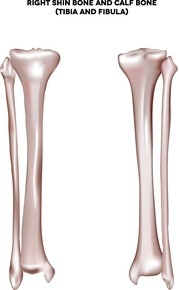

What is the Shin?
The lower leg, between your knee and ankle, is made up of two bones: the tibia and the fibula. The tibia is known more commonly as the shin bone, connected to the fibula through joints, muscles and connective tissue.
 What are Shin Splints?
What are Shin Splints?
Shin Splints are otherwise known as medial or lateral tibial stress syndrome. This condition causes an inflammation of the muscles, tendons and bone tissue around the tibia. Pain with shin splints is often felt along the inner or outer edge of the shin bone.
Common Causes
Often, this injury is grouped in with other types of “overuse injuries”. When your body isn’t given enough time or training to adapt to the stresses of activities like running, the muscles and connective tissues surrounding the tibia can become inflamed and painful. This can happen from overtraining or increasing running distance too quickly. Other factors that may predispose someone to developing shin splints are improper footwear or foot alignment.
Diagnosis and Examination
To receive a diagnosis, a qualified healthcare professional in musculoskeletal disorders will perform an examination. They will look to reproduce the pain in your shin, as well as examine foot alignment, footwear and walking. Questions about activities and symptom history will help to rule out other diagnoses associated with the shin such as a stress fracture.
Treatment Options
This condition is usually treated non-surgically. The first step towards healing is to rest from the activities that cause pain. Using anti-inflammatory medicines like ibuprofen or aspirin can help to reduce swelling and pain. Using ice and cold packs several times a day can also help.
Treatment may also include wearing proper supportive shoes and making sure the shoes are the correct fit. You may be fit for an orthotic if the shape of your foot requires more support to stabilize and relieve stress on other joints. There are a variety of types of orthotics; some may be purchased off the shelf while others are custom made. In addition wearing compression stockings can help to prevent swelling.
To prevent shin splints from recurring, make sure to slowly introduce new activities, build slowly to new distances (2-5 miles per week) and make sure footwear is in proper shape.
Copyright © www.orthopaedics.win Bone Health All Rights Reserved